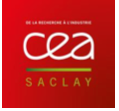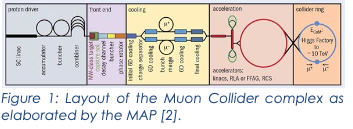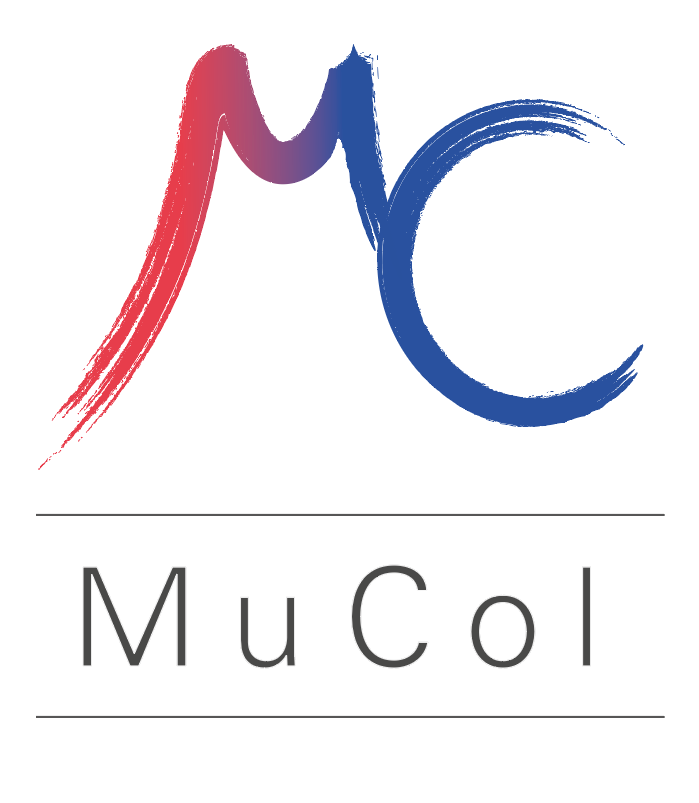COMMISSARIAT A L’ENERGIE ATOMIQUE (CEA) DE SACLAY – FRANCE. 
ROPOSAL PHD SUBJECT
« Design of pulsed synchrotrons for the high-energy acceleration chain for a muon collider»
DESCRIPTION AND PROBLEMATIC
The recent European Accelerator R&D Roadmap [1] includes a 10 or more TeV Muon Collider. This novel interest is based on two considerations: the recognition of the physics potential of a lepton col- lider with a centre-of-mass energy of 10 TeV or more, and the recent advances in technology that make the realisation of a muon collider plausible. The muon collider promises to expand the lepton collider energy reach. Muons are much heavier than electrons and with a much reduced synchro- tron radiation, allowing acceleration and collision of the beam in rings, even at multi-TeV energies.
This results in compact dimensions and promises high efficiency and limited cost. Because muons are point-like particles, in contrast to the compo- site hadrons, a muon collider may have a physics case of comparable interest than a 100 TeV hadron collider. The MuCol project will address the core of the key challenges of a muon collider. It will de- velop the baseline design and assess the physics performance based on realistic performance goals for the collider components. It will identify also the cost and power consumption drivers. This will al- low the next European Strategy for Particle Physics Update process to seriously consider also Muon Colliders for the selection of the next large collider to be built in Europe.

The thesis will focus on the high-energy accelera- tion chain after the cooling channel up to the col- lider. The energy range is thus from about 20 GeV to 5 TeV. The baseline is made of 4 pulsed synchro- trons. The main constraint is to get a very fast ac- celeration (in a few milliseconds) to go to the col- lider energy to avoid the muon decay, which makes this project unique.
A first challenge will be to get a coherent parame- ter table which takes into account the different
constraints. For instance, the parameter table will have to integrate the limitations on the footprint, the maximum gradient in the cavities, the maxi- mum field in the magnets, or the aperture limita- tions coming from collective effects.
A second challenge is to integrate the specific fea- tures of pulsed synchrotrons and especially hybrid synchrotrons. Indeed, to reduce the total RF volt- age, the pulsed synchrotrons need to be as com- pact as possible. However, the very fast accelera- tion makes impossible to ramp NbTi or Nb3Sn di- poles. The baseline uses hybrid synchrotrons with pulsed normal conducting and static supercon- ducting dipoles. The advantage is to get a higher average dipole field and thus a more compact syn- chrotron. The drawback is to have different trajec- tories during the ramp. The tracking in these syn- chrotron has to take into account the different or- bits and path lengths.
The optics to provide for the different pulsed syn- chrotrons is also specific. Indeed, because of the fast acceleration and thus large total voltage, the synchrotron tune is very large. A direct conse- quence is to distribute the RF cavities along the ma- chine instead of one or two dedicated insertions. Moreover, collective effects require a large mo- mentum compaction. The optics challenge is to cancel synchro-betatron resonances (for instance with non-dispersive sections) by keeping a large momentum compaction. The thesis will have to compare and optimize different cells.
Finally, the thesis will address the correction of or- bit errors for the slow ones and evaluate how to mitigate dynamic errors.
The PhD student will use Mad-X [3] to make the op- tics design of the pulsed synchrotrons. The tracking studies will be performed with Xsuite [4].
DESCRIPTION OF THE GROUP/LABO/MANAGEMENT
The PhD will take place at DACM (Department of the Accelerators, Cryogenics and Magnetism) in LEDA (Laboratory of study and Development of Ac- celerators) at CEA Paris-Saclay. The DACM has a
long experience in conceiving charged particle ac- celerators. The DACM has for example contributed to the upgrade of the LHC, the HL-LHC project [5], or to the project of a future proton-proton collider of 100 TeV using the same tunnel as FCC-ee, the FCC-hh project [6]. The DACM is also implied in novel accelerating techniques like the laser-plasma acceleration [7]. The DACM leads the work package on the high energy complex in the MuCol project.
PROPOSED WORK
The PhD student will join an international collabo- ration grouping top-level laboratories like CERN, STFC, or BNL.
Firstly, the PhD student will update an existing code to integrate different scaling laws to get a pa- rameter table of the high-energy complex. This code will enable to get a starting point for the pa- rameters of each pulsed synchrotron (for instance injection energy, or the dipole length).
Secondly, the PhD student will make the optics of the different synchrotrons. In the first year, the PhD student will focus on the first pulsed synchro- tron, which is not hybrid. The PhD student will work in close collaboration with different experts (mag- nets, RF cavities, and collective effects) to find the best balance between a fast acceleration, the state-of-the art and stability issues. That is a great opportunity for the PhD student to get a top-level view of an accelerator and to deepen his/her un- derstanding of the machine design.
Finally, the PhD student will perform tracking stud- ies to study the whole acceleration of the muons (muons only run a few tens of turns in the synchro- trons). The final goal is to show that a fast acceler- ation is possible by keeping a good beam quality for the collisions. A tolerance study with correction will be performed at this stage.
The PhD work will be a strong contribution to the feasibility study of a muon collider. Indeed, the work will enable to check if that is possible to keep the beam properties with a so fast acceleration, to get a cost estimation, and to give some input for the next European Strategy. That is also a way for the PhD student to work on a unique acceleration complex and to work on new concepts like a hybrid synchrotron.
FORMATION AND REQUIRED SKILLS
In the best case master in accelerator physics or master/engineer degree comfortable with numeri- cal and analytical calculation.
CONTACTS
Antoine Chancé: antoine.chance@cea.fr
Doctoral school: PHENICS
REFERENCES
[1] European Strategy for Particle Physics -- Accelerator R&D Roadmap, https://arxiv.org/abs/2201.07895
[2] JINST Special Issue, Muon Accelerators for Particle Physics (MUON), https://iopscience.iop.org/journal/1748- 0221/page/extraproc46
[3] MAD-X code, https://mad.web.cern.ch/mad/
[4] Xsuite code, https://xsuite.readthedocs.io/en/latest/
[5] B. Dalena, J. Payet J, A. Chancé, R. De Maria, Alternative high luminosity LHC matching section layout, in Proceedings of 5th International Particle Accelerator Conference (IPAC 2014), Dresden, Germany, 2014
[6] A. Chancé et al. , Consolidated Lattice of the Collider FCC- hh, 10th Int. Particle Accelerator Conf.(IPAC'19), Melbourne, Australia, 19-24 May 2019, 428-431, 201
[7] X. Li, A. Chancé, P-A-P Nghiem, Preserving emittance by matching out and matching in plasma wakefield acceleration stage, Physical Review Accelerators and Beams, 22, 2, 021304, 2019
